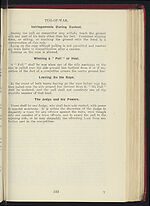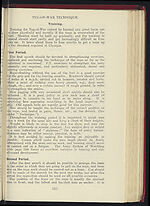1935-36
(574)
Download files
Complete book:
Individual page:
Thumbnail gallery: Grid view | List view

HINTS ON TRAINING A TUG-OF-WAR TEAM.
Selection of Men to Train.
Under Royal Tournament Rules, a Tug-of-War team consists
of ten men and one coach. There are two weights of team,
namely:—
(1) The Heavy-weight Team, not exceeding 130 stone.
(2) The Light-weight Team, not exceeding 110 stone.
In selecting men for either team, it should be borne in mind that
Tug-of-War is an exceedingly strenuous exercise and training for
it can be very monotonous. The men selected must therefore be
definitely keen, hardworking and cheerful characters. Any man
of surly disposition or given to frequent grousing is much better
left out of the team as he will have a very bad effect on the
others.
The men should be of stocky build, with broad shoulders, thick
thighs and legs, and well-developed arms. They should be as
nearly as possible all the same size. Above ill, they must have
plenty of grit and be prepared to put up with any amount of
hard work.
It is comparatively easy to find a light-weight team in a Unit,
but it is much more difficult to find a team of ten well-developed
men totalling 130 stone. The fat, flabby man is useless, no matter
how heavy he may be. If difficulty is experienced in selecting
the Heavy-weight team, it should be remembered that keenness,
strength and stamina are more important than actual weight, and
it is better to have ten really good men a little under weight
rather than to put in a couple of substitute men to make up the
weight.
Kit and Apparatus.
The following kit is recommended for training purposes:—
Old football vests—at least two per man, to allow for frequent
washing.
Old football shorts—as for vests.
A high-neck sweater—for use in cold weather and on road-
work; failing which a Service cardigan and muffler.
Old boots—as long as the soles are reasonably good.
For competition work it is essential that really good boots
should be worn.
The standard size of a Tug-of-War rope is four inches in
circumference and 140 feet long. The length is immaterial as far
as training is concerned, but if possible train with a rope of the
correct thickness.
A derrick or gyn is useful in the early stages of training.
The " weight " should be an old coal box filled with scrap iron,
so that the weight can be easily varied. Wire should be used to
connect the " weight " to the tug-of-war rope. The wire should
run
round the pulley at the top of the derrick, and then run round
a pulley at the base, so that the loop to which the rope is attached
is at a height of not more than 1S inches above the ground.
524
Tr,
be d
start
gene
goes
to tl
Firs
!
road
indis
gene
heav
R
I for t
of
n
flak
plou
to S
i
Sl
inch
new
Burp.
grip.
11
the
undr
TI
once
IV
sligl
is
a
Stall
It
poss
inter
be
(vid
all•r
See
A
in t
nelti
still
: peri
�� may
Selection of Men to Train.
Under Royal Tournament Rules, a Tug-of-War team consists
of ten men and one coach. There are two weights of team,
namely:—
(1) The Heavy-weight Team, not exceeding 130 stone.
(2) The Light-weight Team, not exceeding 110 stone.
In selecting men for either team, it should be borne in mind that
Tug-of-War is an exceedingly strenuous exercise and training for
it can be very monotonous. The men selected must therefore be
definitely keen, hardworking and cheerful characters. Any man
of surly disposition or given to frequent grousing is much better
left out of the team as he will have a very bad effect on the
others.
The men should be of stocky build, with broad shoulders, thick
thighs and legs, and well-developed arms. They should be as
nearly as possible all the same size. Above ill, they must have
plenty of grit and be prepared to put up with any amount of
hard work.
It is comparatively easy to find a light-weight team in a Unit,
but it is much more difficult to find a team of ten well-developed
men totalling 130 stone. The fat, flabby man is useless, no matter
how heavy he may be. If difficulty is experienced in selecting
the Heavy-weight team, it should be remembered that keenness,
strength and stamina are more important than actual weight, and
it is better to have ten really good men a little under weight
rather than to put in a couple of substitute men to make up the
weight.
Kit and Apparatus.
The following kit is recommended for training purposes:—
Old football vests—at least two per man, to allow for frequent
washing.
Old football shorts—as for vests.
A high-neck sweater—for use in cold weather and on road-
work; failing which a Service cardigan and muffler.
Old boots—as long as the soles are reasonably good.
For competition work it is essential that really good boots
should be worn.
The standard size of a Tug-of-War rope is four inches in
circumference and 140 feet long. The length is immaterial as far
as training is concerned, but if possible train with a rope of the
correct thickness.
A derrick or gyn is useful in the early stages of training.
The " weight " should be an old coal box filled with scrap iron,
so that the weight can be easily varied. Wire should be used to
connect the " weight " to the tug-of-war rope. The wire should
run
round the pulley at the top of the derrick, and then run round
a pulley at the base, so that the loop to which the rope is attached
is at a height of not more than 1S inches above the ground.
524
Tr,
be d
start
gene
goes
to tl
Firs
!
road
indis
gene
heav
R
I for t
of
n
flak
plou
to S
i
Sl
inch
new
Burp.
grip.
11
the
undr
TI
once
IV
sligl
is
a
Stall
It
poss
inter
be
(vid
all•r
See
A
in t
nelti
still
: peri
�� may
Set display mode to:
![]() Universal Viewer |
Universal Viewer | ![]() Mirador |
Large image | Transcription
Mirador |
Large image | Transcription
| Games and sports in the army > 1935-36 > (574) |
|---|
| Permanent URL | https://digital.nls.uk/248715832 |
|---|
| Description | 'Games and Sports in the Army' was an annual publication produced by the British War Office between the 1930s and 1960s. This included the Second World War. It outlines the rules and regulations for games and sports played by members of the armed forces. It features names and photographs of team members, and examples of contemporary advertising. |
|---|---|
| Shelfmark | GWB.52 |

